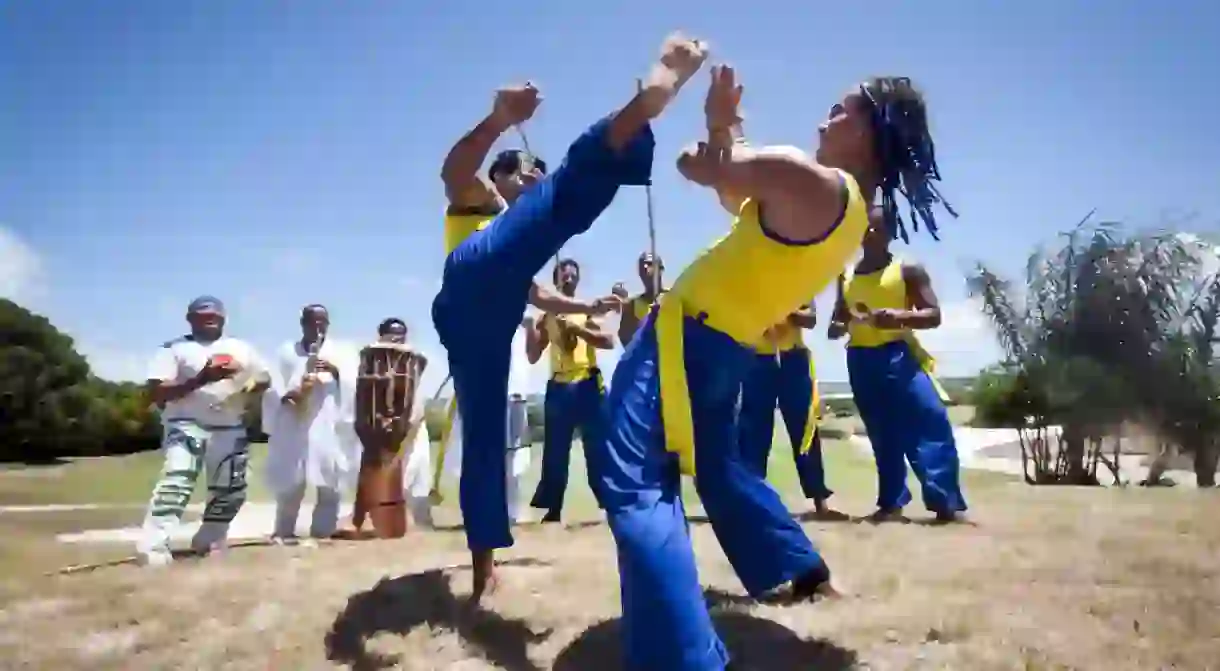A History of Brazilian Capoeira

A mesmerizing blend of acrobatics, dance, martial arts, and hypnotizing music, capoeira is deeply embedded in Brazilian culture, its influence apparent throughout Brazil’s history and in its ever-increasing popularity today. Developed in Brazil mainly by West Africans over 500 years ago, it’s known for its quick and complex series of movements that combine speed and power into a variety of sharp kicks and agile techniques.
History Of Capoeira
Capoeira began with the start of slavery in Brazil in the 16th century, when the Portuguese exported huge numbers of slaves to populate and work the vast lands of recently colonized Brazil. These slaves came mostly from Angola and Congo and were put to work growing and harvesting sugar cane, which was Brazil’s main economic source.

The Slaves That Got Away
Some slaves managed to flee from the sugar cane farms and settle into quilombos, which were small, primitive settlements that were difficult to locate and reach. These settlements began to grow in size, attracting increasing numbers of escaped slaves as well as Brazilian natives and Europeans fleeing Christian extremism. It was in these communities that capoeira began to evolve as a means of defense against the colonial troops.
The largest quilombo was known as Quilombo dos Palmares, and it managed to ward off numerous attacks from Portuguese soldiers. The latter were caught off guard by the unpredictability of the fights and the ‘strangely moving fighting techniques’ of the quilombo residents.


Growth Of Capoeira
Capoeira practice developed in tandem with the economic growth of Brazil. However, it was soon banned due to its association with crime and violence against the colonial government, and the practice was met with severe physical punishment. Further, warlords and criminals employed capoeiristas as hitmen and bodyguards, which led people to fear those skilled in capoeira.
All of this changed in the early 1900s when repression eased and the first capoeira schools opened, allowing capoeira to shed its criminal associations. Today, capoeira is one of Brazil’s most significant cultural exports and is considered to be an element of Intangible Cultural Heritage.

Techniques
The focus of capoeira is attack when the capoeirista is outnumbered or has no weapons. Nowadays, emphasis is placed on style, with capoeiristas forming a circle known as a roda while pairs perform various moves in the center to the rhythmic beats of music. The style demands movement primarily in the lower body and involves kicking out, sweeping across the floor, and taking down opponents. The upper body plays a secondary role in these movements and balances the action.



The performance of capoeira demonstrates a series of complex positions that make up an uninterrupted chain of unpredictable movements. The most fundamental move in capoeira is ‘ginga,’ an important defense and attack move. It serves two purposes: the first is to keep the capoeirista in motion, and the second is to trick and mislead opponents.
Capoeira focuses on avoiding attacks with evasive moves rather than blocking them. Attack is encouraged at any opportunity. In the past, capoeira was practiced with knifes, though this is now largely absent from training. It is common to see public displays of capoeira with performing pairs holding back, slowing down their kicks to avoid making physical contact and injuring one another. Highly skilled capoeiristas’ performances can be aggressive and dangerous, yet danger is rarely seen in public presentations.
The visuals and music are a memorizing mix, and skilled capoeiristas demonstrate individual human skill while illuminating an art that represents layers of social history and culture. Its presence in Brazilian culture is stronger than ever, and it remains a vital testament to the country’s complex history.
















